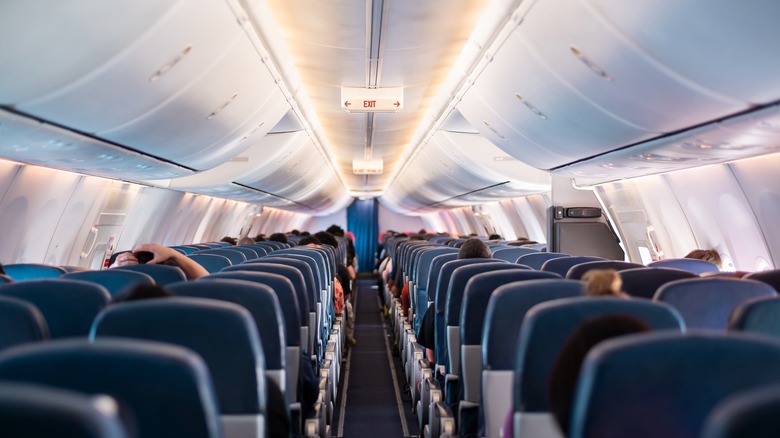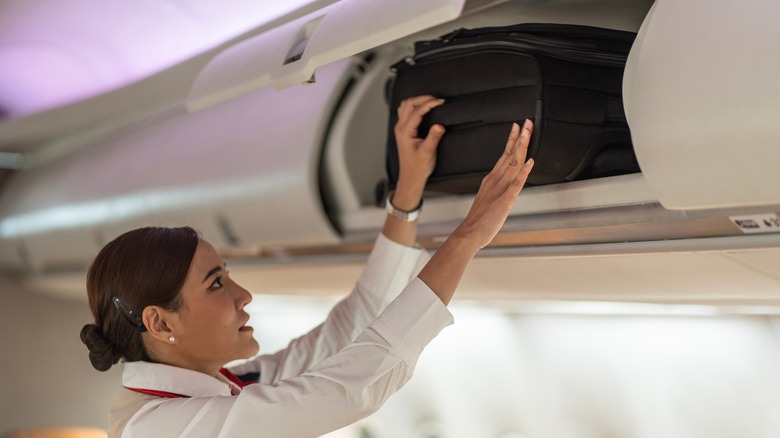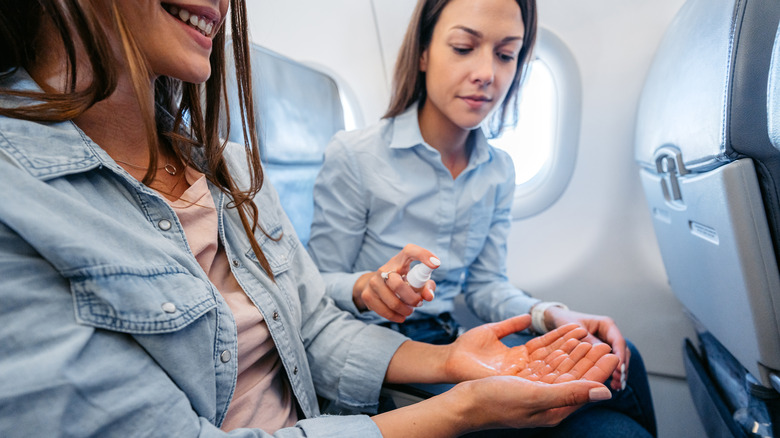The Unavoidable Part On A Plane That's Dirtier Than People Realize, Per A Flight Attendant
There are things on a plane that you can't avoid touching, no matter how full of germs they might be. You have to use the seatbelt to comply with flight attendant instructions. The headrest and armrest are pretty unavoidable as well, unless you're really good at sitting bolt-upright with your hands in your lap for hours. Along with the air vent, the tray table, and the seatback pocket, these spots can be pretty dirty. But one mostly unavoidable area you might not consider when thinking about the germiest spots on the plane is the overhead bin latch.
If you check your only bag, it's possible that you won't have to use it. However, with checked baggage fees, many people are choosing to shove everything they brought with them in the overhead bins. That means a lot of hands are touching that latch, during and after the flight. While we're worried about people stuffing the overhead bins with jackets and other things that aren't supposed to go in there, we could be getting sick from touching a spot we don't even think about.
The dirty overhead bin and your health
Planes are deep cleaned, but only every 30-45 days or so. Sometimes, if a plane is on the ground overnight, there will be a good cleaning, but there are times when it's just a quick tidy-up before the next set of passengers. Former flight attendant Catrina McGrail told Afar, "The allocated time to clean is extremely tight, so staff have to be extremely efficient and quick ... often the staff are given only around 10 minutes to clean the whole plane!" If you've ever had just 10 minutes to tidy up a room before company, you know that things get missed.
The latch on the overhead bin isn't going to get wiped down that often, and while you might be the lucky one who boards early on a flight that has just been deep cleaned, that's a Goldilocks scenario. Even if you do, other people are likely going to be getting things from their bags during the flight, and someone has to open it up when you land. That doesn't even take into consideration the inside, which you might be touching when you adjust your luggage. The wheels of everyone's carry-on bags have been dragged through the airport, rolling along the ground, and now they're resting on that surface. It's a good idea to use a sanitizing wipe on the spot before opening or closing the bin, or antibacterial gel on your hands after you do so.
Other places to avoid on planes and how to stay safer
The issue isn't necessarily getting the germs on our hands. It's the next step, which is touching them to our eyes, noses, and mouths. Mark Gendreau, the chief medical officer at Beverly and Addison Gilbert Hospitals told AARP that we introduce about 80 percent of infectious diseases to our own bodies this way. He added, "My favorite factoid: Humans touch their faces about 200 times a day."
Gendreau also mentioned that the stress of travel can make us engage in nervous behaviors like biting our nails, which puts those germs in contact with our mouths. A good solution? Hand sanitizer and disinfectant wipes with at least 60 percent alcohol are your best bet. When you enter the plane and sit down, you can wipe down the tray table, the seat cover and headrest, the seatbelt, and the safety card, in addition to using a wipe when touching the bin. Use hand sanitizer after you touch the bathroom door handle and lock as well. Other spots include the entertainment touchscreen and controls.
Here's another thing you can do to stay healthy on the plane. Bring your own water bottle and fill it up at the airport after you pass security, as the dry plane air can dry out mucus membranes and make us more vulnerable to germs. However, skip water, coffee, and tea on the plane, and don't order drinks with ice as the water tanks aren't cleaned very often.


